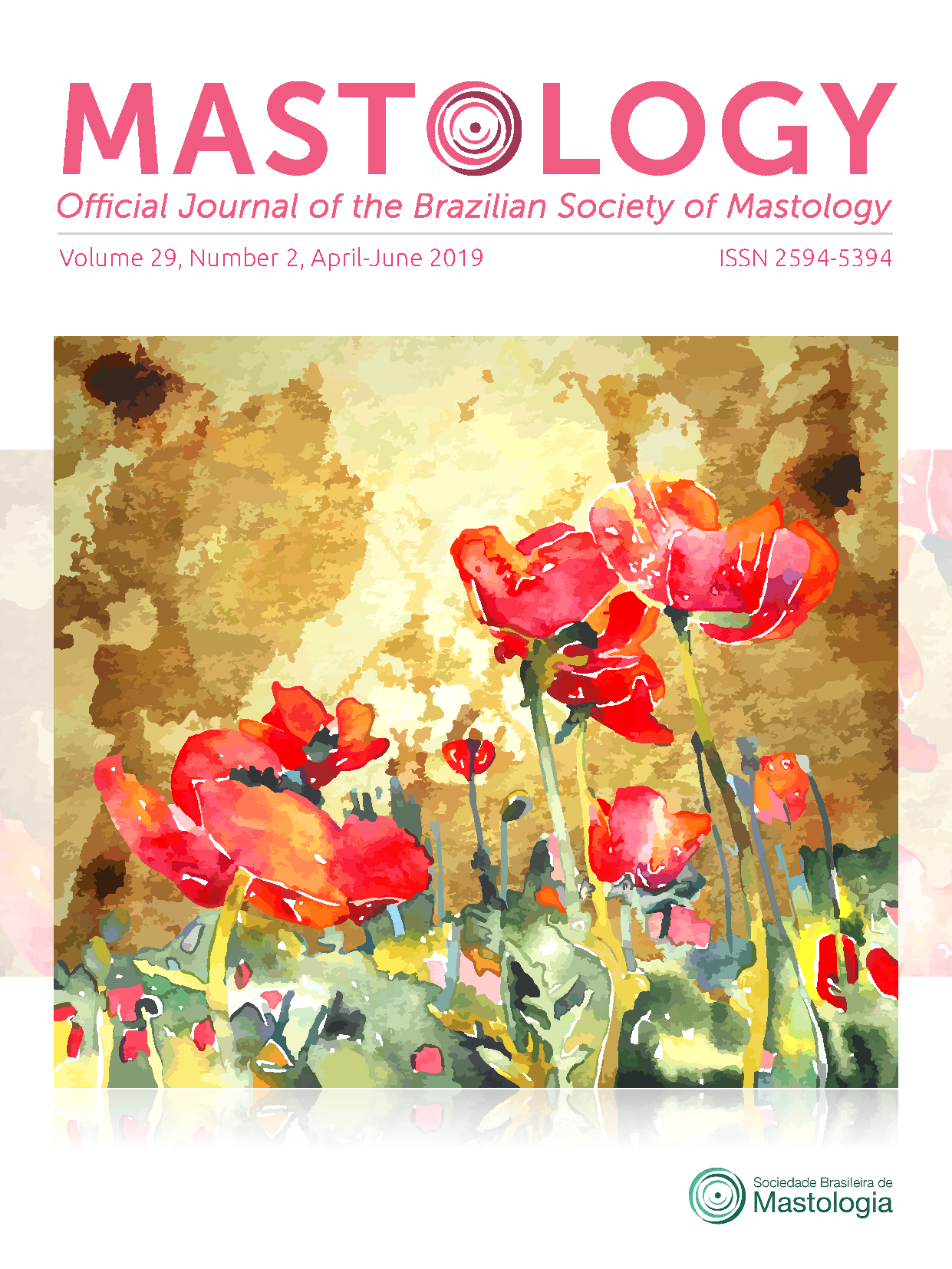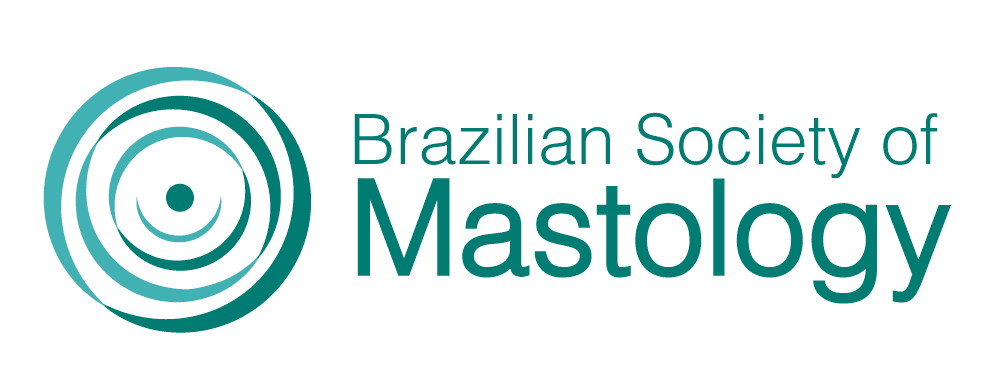Avaliação do uso da imunocitoquímica no diagnóstico dos tumores papilares mamários em punção aspirativa de agulha fina
Palavras-chave:
papiloma intraductal, biópsia por agulha fina, imuno-histoquímica, antígeno Ki-67; patologiaResumo
Objetivo: Este estudo observou a efetividade do método imunocitoquímico no diagnóstico das lesões papilares de mama a partir de amostras por punção aspirativa por agulha fina (PAAF), para validar o método que, aplicado à prática clínica, evitaria a exérese desnecessária dos pequenos papilomas intraductais da mama. Métodos: Foram analisados prontuários e exames de PAAF durante o período de 2003 a 2012 e posteriormente realizado exame imunocitoquímico com marcador de célula mioepitelial p63 e índice proliferativo Ki67, analisando-se especificidade e sensibilidade dos marcadores no diagnóstico de lesões papilares da mama. Resultados: A imunocitoquímica dos materiais das lesões papilares mamárias com os imunomarcadores Ki67 e p63 apresentou sensibilidade de 78,6% e especificidade de 73,33% na identificação das lesões benignas. Conclusões: O uso combinado desses marcadores em PAAF de lesão papilar mamária auxilia na orientação terapêutica da doença, mas novos estudos incluindo um maior número de casos devem ser realizados para melhor avaliar esse método.
Downloads
Referências
Pal SK, Lau SK, Kruper L, Nwoye U, Garberoglio C, Gupta RK, et al. Papillary carcinoma of the breast: an overview. Breast Cancer Res Treat. 2010;122(3):637-45. https://doi.org/10.1007/s10549‑010‑0961‑5
Willems SM, van Deurzen CHM, van Diest PJ. Diagnosis of breast lesions: fine-needle aspiration cytology or core needle biopsy? A review. J Clin Pathol. 2012;65(4):287-92. http://dx.doi.org/10.1136/jclinpath-2011-200410
Frankel PP, Esteves VF, Thuler LCS, Vieira RJ da S. Acuracia da puncao aspirativa por agulha fina e da puncao por agulha grossa no diagnostico de lesoes mamarias. Rev Bras Ginecol Obs. 2011;33(3):139‑43. http://dx.doi.org/10.1590/S0100‑72032011000300007
Aggarwal D, Soin N, Kalita D, Pant L, Kudesia M, Singh S. Cytodiagnosis of papillary carcinoma of the breast: Report of REFERENCES a case with histological correlation. J Cytol. 2014;31(2):119-21. https://dx.doi.org/10.4103%2F0970-9371.138694
Gobbi H. Classificacao dos tumores da mama: atualizacao baseada na nova classificacao da Organizacao Mundial da Saude de 2012. J Bras Patol Med Lab. 2012;48(6):463-74. http://dx.doi.org/10.1590/S1676-24442012000600013
Zhao L, Yang X, Khan A, Kandil D. Diagnostic Role of Immunohistochemistry in the Evaluation of Breast Pathology Specimens. Arch Pathol Lab Med. 2014;138(1):16-24. https://doi.org/10.5858/arpa.2012-0440-RA
Dewar R, Fadare O, Gilmore H, Gown AM. Best practices in diagnostic immunohistochemistry: Myoepithelial markers in breast pathology. Arch Pathol Lab Med. 2011;135(4):422-9. https://doi.org/10.1043/2010-0336-CP.1
Aikawa E, Kawahara A, Kondo K, Hattori S, Kage M. Morphometric analysis and p63 improve the identification of myoepithelial cells in breast lesion cytology. Diagn Cytopathol. 2010;39(3):172-6. https://doi.org/10.1002/dc.21353
Hafez NH, Tahous NS. The Role of P63 Immunocytochemistry for Myoepithelial Cells in the Diagnosis of Atypical and Suspicious Cases in Breast Fine Needle Aspiration Cytology (FNAC). J Egypt Natl Canc Inst. 2010;22(2):123-34.
Reisenbichler ES, Adams AL, Hameed O. The Predictive Ability of a CK5/p63/CK8/18 Antibody Cocktail in Stratifying Breast Papillary Lesions on Needle Biopsy: An Algorithmic Approach Works Best. Am J Clin Pathol. 2013;140(6):767-79. https://doi.org/10.1309/AJCPXV64GXLZCIGA
Parthasarathi K. Ki-67: a review of utility in breast cancer. Aust Med Student J. 2015;6(1):102–4.
Zaha DC. Significance of immunohistochemistry in breast cancer. World J Clin Oncol. 2014;5(3):382-92. https://dx.doi.org/10.5306%2Fwjco.v5.i3.382
Al-Maghraby H, Ghorab Z, Khalbuss W, Wong J, Silverman JF, Saad RS. The diagnostic utility of CK5/6 and p63 in fine-needle aspiration of the breast lesions diagnosed as proliferative fibrocystic lesion. Diagn Cytopathol. 2012;40(2):141-7. https://doi.org/10.1002/dc.21534
Tse GM, Ni Y-B, Tsang JYS, Shao M-M, Huang Y-H, Luo M-H, et al. Immunohistochemistry in the diagnosis of papillary lesions of the breast. Histopathology. 2014;65(6):839-53. https://doi.org/10.1111/his.12453
Boin DP, Baez JJ, Guajardo MP, Benavides DO, Ortega ME, Valdes DR, et al. Breast papillary lesions: an analysis of 70 cases. Ecancermedicalscience. 2014;8:461. https://dx.doi.org/10.3332%2Fecancer.2014.461
Wiratkapun C, Keeratitragoon T, Lertsithichai P, Chanplakorn N. Upgrading rate of papillary breast lesions diagnosed by core-needle biopsy. Diagnostic Interv Radiol. 2013;19:371-6. https://dx.doi.org/10.5152/dir.2013.017
Bianchi S, Bendinelli B, Saladino V, Vezzosi V, Brancato B, Nori J, et al. Non-Malignant Breast Papillary Lesions - B3 Diagnosed on Ultrasound - Guided 14-Gauge Needle Core Biopsy: Analysis of 114 Cases from a Single Institution and Review of the Literature. Pathol Oncol Res. 2015;21(3):535-46. https://doi.org/10.1007/s12253-014-9882-7
Prathiba D, Rao S, Kshitija K, Joseph L. Papillary lesions of breast: An introspect of cytomorphological features. J Cytol. 2010;27(1):12-5. https://doi.org/10.4103/0970-9371.66692
Moon HJ, Jung I, Kim MJ, Kim E-K. Breast Papilloma without Atypia and Risk of Breast Carcinoma. Breast J. 2014;20(5):525‑33. https://doi.org/10.1111/tbj.12309
Jagmohan P, Pool FJ, Putti TC, Wong J. Papillary lesions of the breast: imaging findings and diagnostic challenges. Diagn Interv Radiol. 2013;19(6):471-8. https://doi.org/10.5152/dir.2013.13041
Choi SH, Jo S, Kim D-H, Park JS, Choi Y, Kook S-H, et al. Clinical and Imaging Characteristics of Papillary Neoplasms of the Breast Associated with Malignancy: A Retrospective Cohort Study. Ultrasound Med Biol. 2014;40(11):2599-608. https://doi. org/10.1016/j.ultrasmedbio.2014.06.018
Menes TS, Rosenberg R, Balch S, Jaffer S, Kerlikowske K, Miglioretti DL. Upgrade of high-risk breast lesions detected on mammography in the Breast Cancer Surveillance Consortium. Am J Surg. 2014;207(1):24-31. https://doi.org/10.1016/j.amjsurg.2013.05.014
Kuzmiak CM, Lewis MQ, Zeng D, Liu X. Role of Sonography in the Differentiation of Benign, High-Risk, and Malignant Papillary Lesions of the Breast. J Ultrasound Med. 2014;33(9):1545-52. https://doi.org/10.7863/ultra.33.9.1545
Kestelman FP, Gomes CFA, Fontes FB, Marchiori E. Imaging findings of papillary breast lesions: A pictorial review. Clin Radiol [Internet]. 2014;69(4):436-41. https://doi.org/10.1016/j. crad.2013.11.020
Pathmanathan N, Balleine RL. Ki67 and proliferation in breast cancer. J Clin Pathol. 2013;66(6):512-6. https://doi.org/10.1136/jclinpath-2012-201085
Downloads
Publicado
Como Citar
Edição
Seção
Licença
Copyright (c) 2019 Fábio Postiglione Mansani, Marina Bertucci, Mário Rodrigues Montemór Netto, Luiz Martins Collaço, Jorge Felipe do Lago Pereira dos Santos

Este trabalho está licenciado sob uma licença Creative Commons Attribution 4.0 International License.







